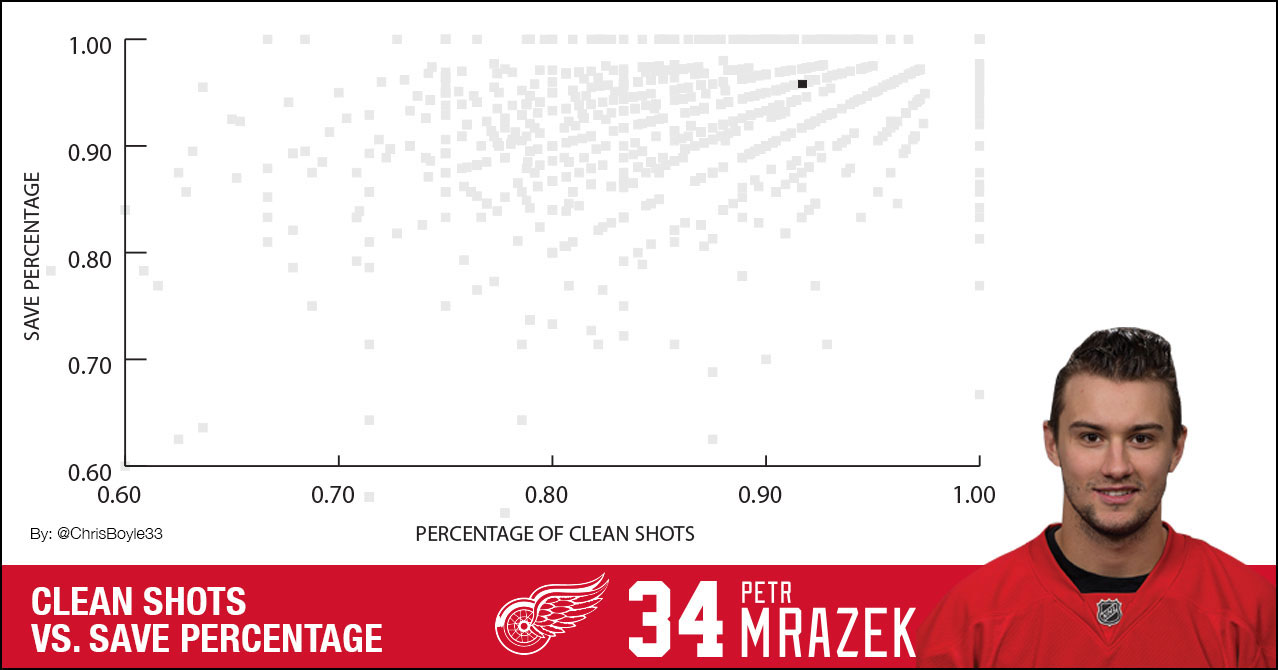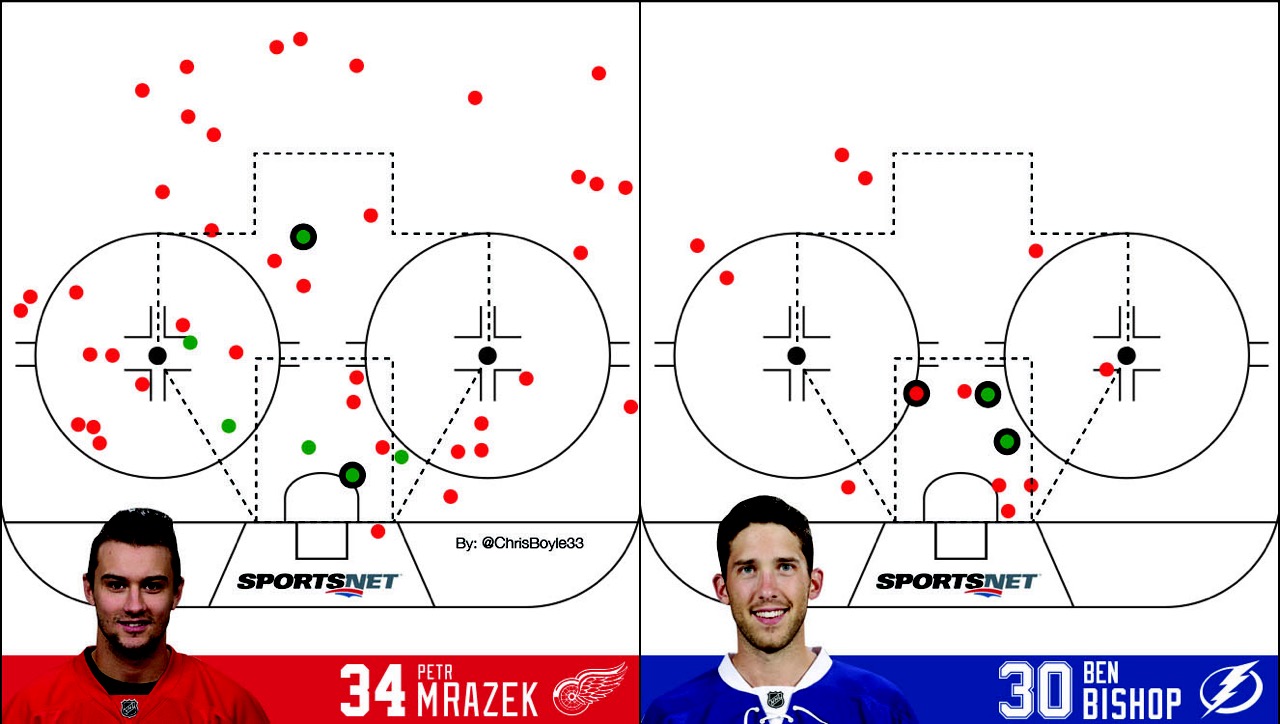Playoff hockey always breeds unlikely heroes. Many of these heroes are little known goaltenders who rise from obscurity to lead their teams on unexpected playoff runs.
Last night Petr Mrazek raised his hand and pushed Andrew Hammond aside as this seasons top candidate.
One week ago Jimmy Howard gift wrapped a victory for the Montreal Canadiens and assured the Red Wings of a first-round meeting with the Tampa Bay Lightning. Mike Babcock didn’t offer his vote of confidence and it opened the door for the little known Mrazek to run with the playoff starters job.
I looked at this last year in regards to coaching decisions and how sometimes it is easier to go with the unknown because of the chance of greatness then to roll with what you already know is mediocre. Jimmy Howard hasn’t really proven himself to be among the elite of the league, so Babcock’s decision is totally defensible.
Defensible turned to apparent genius on Thursday. Mrazek seemingly stole a Game 1 win vs the Lightning. But did he really?
We already know how important possession is to playoff success. The way Tampa manhandled Detroit through puck possession in Game 1 generally leads to victory, but one game samples can mess with probability and prediction.

courtesy of war-on-ice.com
Our perception is always influenced by the shot clock. When it reads 46-14 we are always going to assume that an outstanding goaltender performance occurred. A .957 SV% will always carry a ton of weight, but during a viewing of the highlights from Mrazek’s outstanding performance, I noticed a stark contrast from the previous night’s hero, Blackhawks goaltender Scott Darling, who made 3-4 highlight of the night saves.
Possessing the puck to the extent the Lightning did will eventually lead to fortune over the long haul, but firing pucks from distance requires layering bodies in front of the net to alter sightlines, to block a goaltenders vision on pre-shot movement, tip pucks and alter the trajectory and be in position should rebounds drop into the scoring area. When done successfully, the breaks you are looking for will occur.
The problem for the Lightning is they tipped 2 of 46 shots and produced zero rebound shots from a goaltender who was continuously placing secondary opportunities in the slot.
The problem with games like this is that possession has become such a simple way to assess a game, but we don’t really know what to do with the data when we look at this type of performance. So we assume that Tampa had bad luck and Mrazek was outstanding.
The Lightning were a little unlucky, but they also readily accepted the perimeter and didn’t pay the price in front of the net which would have made Mrazek’s life more difficult.
If we look at Mrazek’s ratio of clean looks vs save percentage, we see his workload placed in the high probability of success area. Clean looks on 91 per cent of total pucks is a goaltender playing catch on most opportunities. Clear sightlines. No movement requires perfect shots or relying on goaltender error.

Mrazek delivered an above average performance, but this type of environment is not exactly goalie hell. When we breakdown the game using shot location and marking red vs green to highlight high quality vs low quality, we begin to see how this result becomes possible.
I marked all shot attempts during the game. Pretty easy to see the possession domination by the Lightning when visualized in this manner, but there are a ton of red shots indicating the low value of the real estate the Wings allowed the Lightning to occupy.
Six high quality green opportunities for the Lightning resulted in two goals. The other 64 red resulted in 0. Now here is where fortune comes into the equation. The Red Wings buried the only two green opportunities they had and were rewarded with a gimme by Bishop on a weak shorthanded backhander that squeaked through the five hole.
Removing the shot attempts still shows a dominant Lightning possession performance, but they still struggled to get to the front of the net. When you remove the shots that have an expected goaltender success rate of .950 or more (I call these save percentage inflators) we see how Detroit managed to beat the odds for one night.
With all the zone time, the Lightning were able to penetrate the danger zone 13 times, the Red Wings with their limited zone time managed this 9 times. When we move to the highest danger zone (the box directly in front of the crease) the number favours the Red Wings 7 to 5.
None of this is meant to suggest that Mrazek wasn’t fully deserving of the result, he was perfect on his red opportunities, nor is it meant to suggest that possession isn’t the preferred way for sustained success. It is.
The Wings won because Bishop handed them a goal. When they collapsed and took away the passing lanes, the Lightning became content with pounding them from the exterior.
What the Wings pulled off in Game 1 isn’t really sustainable (try telling that to a Washington Capitals fan) and if they don’t adjust, they are likely looking at a quick exit.
The goaltender tends to get the lions share of the credit when the shot clock reads 40+, but Mrazek stole this as much as Pavel Datsyuk did with his 1.000% shooting percentage. The Red Wings won game one riding unsustainable percentages.
Both teams need to adjust. The Lightning need to create some more offensive zone movement and layer bodies in front of the net and the Red Wings need to figure out a way to get Stamkos away from bulldozing Riley Sheahan. If they don’t, Mrazek will have to channel 2010 Halak for the Red Wings to move on.










